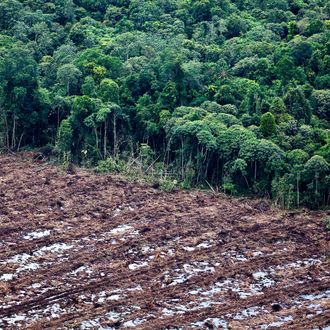
Humans were trashing this planet long before we figured out how to send gobs of greenhouse gas into the atmosphere. Before the dawn of history, we’d already killed off the giant sloths and woolly mammoths of North America, nearly every tree on Easter Island, and all of the megafauna in Australia. Which is to say, climate change may be the most serious charge on our species’ rap sheet, but it isn’t the only one.
A new study on the Earth’s rapidly depleting biodiversity highlights this point. The report, published in Science, finds that across a majority of the Earth’s land the abundance of animal and plant species has fallen below the level deemed “safe” by many biologists. And by “safe” these scientists mean “safe for human survival.”
Our species relies on functioning ecosystems to live. We need crops to be pollinated, water to be filtered, waste to decompose into fertile soil, and the carbon cycle to be regulated. To execute these functions, ecosystems need to maintain a certain level of biodiversity, since these processes are born of the co-evolution of many different organisms. But humans also needed to kill off lots of organisms to proliferate and establish agriculture and industrial civilization. So far, with some minor hiccups (including the collapse of some civilizations), we’ve gotten away with it.
The “planetary boundaries” framework suggests that won’t always be the case. It holds that when humans reduce the biodiversity of a given area by more than 10 percent, the sustainability of the local ecosystem is put at risk. This framework is contested and, in a sense, inherently political: The biologists who embrace this threshold aren’t claiming that crossing it ensures disaster, but, rather, that it constitutes a level of risk we’d be unwise to accept — particularly in light of the reckless experiment we’re conducting in our atmosphere.
“This is definitely a situation where the precautionary principle needs to be applied: we can’t afford to wait to see the long-term consequences of degradation of natural ecosystems,” Owen Lewis, professor of ecology at Oxford University, told the BBC.
The Science study compiles the most detailed analysis of global biodiversity to date, using 1.8 million separate measurements of the profusion of species in 18,659 distinct areas. Employing the “planetary boundaries” standard, researchers found that 58 percent of the Earth’s surface lacked a “safe” amount of biodiversity — and that particular 58 percent happens to be where 71 percent of all humans live. In some populous areas, biodiversity has fallen well below “safe” levels: A giant region in North America, stretching from Canada to Texas, has lost more than 40 percent of its original biodiversity.






























